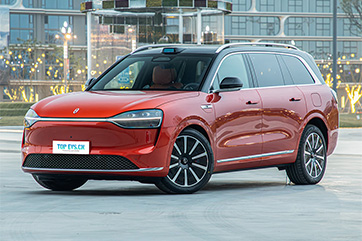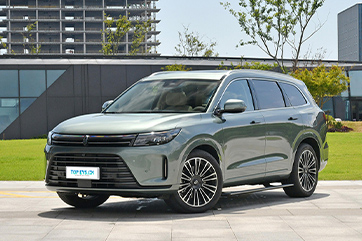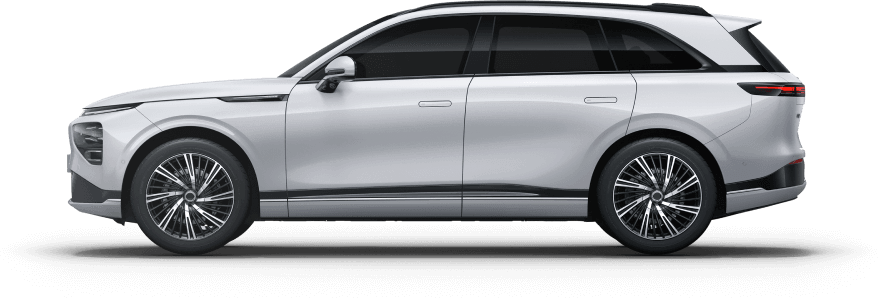As a popular model in the AITO family, the 2026 AITO M7 receives a substantial update in exterior design that not only preserves the family identity but also integrates practical technologies in key details. Body dimensions and interior space have been significantly optimized, and the addition of Huawei’s advanced driver-assist system further strengthens the model’s competitiveness.
From the front, the new model uses the same “Kunpeng Wing” face shared with the AITO M8 and M9. The closed grille hides an active air-intake management system that intelligently adjusts airflow according to driving conditions, balancing cooling needs and drag control. The highly distinctive Star-Ring dual-wing through-type lighting is composed of 720 LEDs; when illuminated it enhances night-time visibility and contributes to the car’s striking look. Combined with the streamlined body, the drag coefficient is as low as 0.28 Cd, laying the foundation for energy efficiency. Notably, LiDAR and millimeter-wave radars are cleverly integrated into the front bumper — the 192-line LiDAR reaches up to 250 m and, together with Huawei ADS 4.0, enables centimeter-level environmental modeling to support high-level driver assistance.
The side profile upgrade is equally impressive. The 2026 AITO M7 measures 5080 × 1985 × 1750 mm with a 3030 mm wheelbase, and the longer wheelbase directly translates into more interior room. Frameless doors paired with semi-hidden door handles enhance sportiness and tech appeal; the handles are engineered to deploy normally even in extreme cold (-30°C). The car rides on 21-inch “Xuan-Yao” wheels with staggered tires — 255/45 R21 (front) and 275/40 R21 (rear) — which preserve grip and add visual presence. New flow-guiding fins on the side skirts optimize airflow and reduce lateral wind noise by 12% at high speeds. A C-pillar triangular window enlarged by 40% noticeably improves third-row daylighting.
Seating and space have been optimized for multiple use cases. The second-row “airline” seats support 165° flat-recline, 16-point massage, and ventilation and heating, reducing long-distance fatigue; the central aisle width is 220 mm, making access to the third row easier. Third-row legroom expands to 850 mm — validated by a 1.8 m passenger test — and the seatback offers 10-position recline for customizable comfort.
The rear balances form and function. The new three-segment through-type taillight houses 256 LEDs and supports dynamic welcome lighting sequences to create a ceremonial effect when unlocking the car. The rear bumper integrates a diffuser form that refines airflow; a hidden wiper and a power tailgate with foot-sensing improve convenience. The trunk opening height is optimized to 780 mm for easier loading and unloading. On BEV variants the exhaust trims are removed in favor of body-colored protective cladding for a cleaner rear appearance.
Storage is designed for daily needs: 23 storage compartments across the vehicle; a 50 L front trunk for charging cables and kits; and a rear cargo area that expands to a maximum of 2380 L to accommodate family trips or large items.
On driver assistance, the Huawei ADS 4.0 hardware package is comprehensive: in addition to the roof-mounted 192-line LiDAR, the car features a rear high-precision solid-state LiDAR, 12 ultrasonic sensors, 5 4D millimeter-wave radars, and 11 cameras. The front uses a three-unit distributed radar matrix and the rear includes two corner radars; an in-cabin LiDAR solution is also applied. This full-suite hardware supports L2+ and above assisted-driving functions with stable, precise perception to enhance safety and driving convenience.
From the tech-forward “Kunpeng Wing” front to the roomy 850 mm third-row legroom and the assurance of Huawei ADS 4.0, every upgrade on the 2026 AITO M7 is designed to meet real user needs. If you want a detailed configuration comparison, or to book an in-person demo, contact us — our team provides 1-to-1 consultation from first inquiry to delivery.

.jpg)
.jpg)
.jpg)
.jpg)
.jpg)

.jpg)
.jpg)
.jpg)
.jpg)
.jpg)
.jpg)
.jpg)
.jpg)






